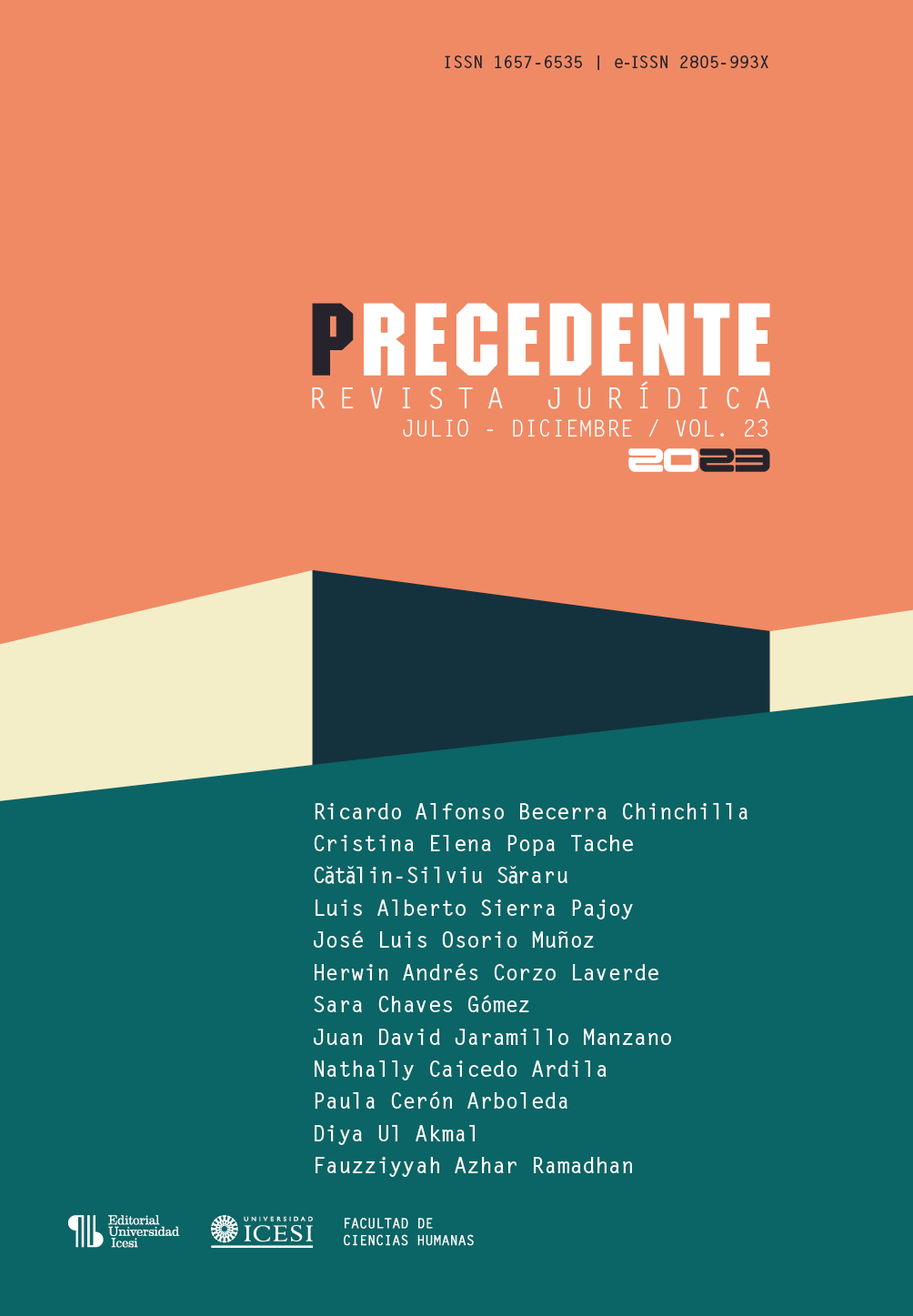El lawfare, entre sus (no)límites y la transdisciplinariedad
DOI:
https://doi.org/10.18046/prec.v23.5889Palabras clave:
lawfare, transdisciplinariedad, sistema legal, estrategia, integridad, transparencia, derecho internacionalResumen
Esta investigación explora el concepto camaleónico de lawfare y su impacto en los sistemas legales y la sociedad en general, centrándose en la interacción entre sus (in)fronteras y la transdisciplinariedad. El análisis se centra en un caleidoscopio de aspectos fundamentales de la justicia, incluyendo las tácticas y estrategias utilizadas en los procesos judiciales, en los conflictos civiles o militares, en el abuso de los procedimientos legales y en la manipulación del sistema legal para lograr fines ilegales, en la regulación de derecho a nivel mundial y nacional, destacando las diferentes formas que puede tomar este fenómeno y su impacto en el Estado de derecho y la democracia. Un aspecto importante de la investigación es el análisis de los límites del derecho, en el sentido de que existen ciertas restricciones éticas, legales y morales al abuso del sistema legal, independientemente de las circunstancias. Las conclusiones se fundamentan en la constatación de que se necesitan regulaciones más claras para proteger la integridad del ordenamiento jurídico y para prevenir abusos legales, hecho que requiere una serie de investigaciones futuras, estableciendo las condiciones que marcan el tránsito de lo legal a lo ilegal. Este artículo fue desarrollado utilizando el método de introspección transdisciplinaria, basado en datos primarios y secundarios de revistas científicas, libros, documentos y otras publicaciones.
Descargas
Referencias
Aalberts, T., Rajkovic, N. M., & Gammeltoft-Hansen, T. (2016). Introduction: Legality, Interdisciplinarity and the Study of Practices. The Power of Legality (pp. 1-26). Cambridge University Press.
Allard, J., & Garapon, A. (2005). Les Juges dans la mondialisation : La nouvelle révolution du droit. Editions du Seuil and La République des idées.
Buga, I. (2018). Modification of Treaties by Subsequent Practice. Oxford.
Butt, S. & Lindsey, T. (2013). Judicial Mafia: The Courts and State Illegality in Indonesia. In E. Aspinall & G. van Klinken (Eds.), The State and Illegality in Indonesia (pp. 189-213). KITLV Press.
Carvalho, A. (2005). Representing the politics of the greenhouse effect. Critical Discourse Studies, 2(1), 1-29.
Charter of Transdisciplinarity. (1994, November 2-6). Adopted at the First World Congress on Transdisciplinarity, Convento da Arrábida, Portugal.
Cheng, D. (2012). Winning Without Fighting: Chinese Legal Warfare. The Heritage Foundation. Retrieved November 25, 2022, from https://www.heritage.org/asia/report/winning-without-fighting-chinese-legal-warfare
Ciutacu, C., Chivu, L., & Jean, V. A. (2017). Land grabbing: A review of extent and possible consequences in Romania. Land Use Policy, 62, 143-150. https://doi.org/10.1016/j.landusepol.2017.01.001
Collins English Dictionary. (n.d.). Lawfare. Retrieved November 23, 2022, from https://www.collinsdictionary.com/dictionary/english/lawfare
Cribb, R. (Ed.). (1990). The Indonesian Killings: Studies from Java and Bali. Centre of Southeast Asian Studies, Monash University.
Davis, D., & Le Roux, M. (2019). Lawfare: Judging Politics in South Africa. Jonathan Ball Publishers.
Didea, I., & Ilie, D. M. (2019). (R)evolution of the insolvency law in a globalized economy. Juridical Tribune - Tribuna Juridica, 9(1), 94-95.
Duczynski, G., Bachmann, S., & Smith, M. (2021). Operational Design, Taming Wicked Problems, and Lawfare. Journal of Information Warfare, 20(3), 73-89.
Dunlap, C. J. (2001). Law and Military Interventions: Preserving Humanitarian Values in 21st Conflicts (Paper presented at the Humanitarian Challenges in Military Intervention Conference). http://scholarship.law.duke.edu/cgi/viewcontent.cgi?article=6193&context=faculty_scholarship
Giddens, A. (1990). The Consequences of Modernity. Polity Press.
Goldenziel, J. (2022, February 20). Ukraine Is Weaponizing Corporations Against Russia-Using Lawfare. Forbes.
Graham, R. (2016). How Terrorists Use Encryption. CTC Sentinel, 9(6), 20-26.
Hadorn, G. H., Hoffmann-Riem, H., Biber-Klemm, S., Grossenbacher-Mansuy, W., Joye, D., Pohl, C., Wiesmann, U., & Zemp, E. (Eds.). (2008). Handbook of Transdisciplinary Research. Springer.
Hasian, M. (2014). Biopolitics and Thanatopolitics at Guantánamo, and the Weapons of the Weak in the Lawfare over Force-Feeding. Law & Literature, 26(3), 343-364.
Hendricks, V. F., & Vestergaard, M. (2019). Reality Lost: Markets of Attention, Misinformation and Manipulation. Springer. Retrieved November 28, 2022, from https://link.springer.com/book/10.1007/978-3-030-00813-0
Hornby, A. S. (1995). Oxford Advanced Learner’s Dictionary of Current English. Oxford University Press.
Joyner, C. C. (2005). International Law in the 21st Century: Rules for Global Governance. Rowman & Littlefield Publishers.
Kittrie, O. F. (2016). Lawfare: Law as a Weapon of War. Oxford Academic.
Konkes, C. (2018). Green Lawfare: Environmental Public Interest Litigation and Mediatized Environmental Conflict. Environmental Communication, 12(2), 191-203.
Lakomy, M. (2022). Why Do Online Countering Violent Extremism Strategies Not Work? The Case of Digital Jihad. Terrorism and Political Violence. https://doi.org/10.1080/09546553.2022.2038575
Lazarus, R. (2009). Super wicked problems and climate change: Restraining the present to liberate the future. Cornell Law Review, 94, 1153-1234.
Lobel, O. (2007). The Paradox of Extralegal Activism: Critical Legal Consciousness and Transformative Politics. Harvard Law Review, 120(4), 937-988.
Lochak, D. (2018). Les migrations transdisciplinaires du droit des étrangers. Quelles causes ? Quels enjeux ? In S. Barbou des Places and F. Audren, Qu’est-ce qu’une discipline juridique ? (pp. 279-294). LGDJ.
Maclean, K. (2012). Lawfare and Impunity in Burma since the 2000 Ban on Forced Labour. Asian Studies Review, 36(2), 189-206.
Matthews, T. (2023). Interrogating the Debates Around Lawfare and Legal Mobilization: A Literature Review. Journal of Human Rights Practice, 15(1), 24-45. https://doi.org/10.1093/jhuman/huac044
McCann, M. W. (1994). Rights at Work: Pay Equity Reform and the Politics of Legal Mobilization. University of Chicago Press.
McGrath, C. (2008). Flying foxes, dams and whales: Using federal environmental laws in the public interest. Environmental and Planning Law Journal, 25(5), 324-359.
Mietzner, M. (2010). Electoral Contestations and Economic Resilience. Asian Survey, 50(1), 185-194.
Morss, J. R. (2013). International Law as the Law of Collectives: Toward a Law of People. Routledge.
Muñoz Mosquera, A., & Muñoz Bravo, A. (2017). The Legal Domain: A Need for Hybrid Warfare Environments. NATO Legal Matters. The Operational Law Quarterly, 2.
Nance, M., & Sampson, C. (2017). Hacking ISIS: How to Destroy the Cyber Jihad. Skyhorse Publishing.
Nicolescu, B. (2002). La transdisciplinarité manifeste (K. C. Voss, Trans.) Rocher. (Original work published in 1996).
Nicolescu, B. (2006). Transdisciplinarity-Past, present and future. In B. Haverkort & C. Reijntjes (Eds.), Moving world-views-Reshaping sciences, policies and practices for endogenous sustainable development. COMPAS Editions.
Nicolescu, B. (2014). Methodology of Transdisciplinarity. World Futures, 70(3-4), 186-199. https://doi.org/10.1080/02604027.2014.934631
Nordau, M. (1921). The Conventional Lies of Our Civilization (M. Cantianu, Trans.). Ed. Socec & Co Bookstore.
Peretz, I. (1915). Course on the History of Romanian Law. Curierul Judiciar.
Piaget, J. (1972). L’épistémologie des relations interdisciplinaires. In G. Berger, A. Briggs, & G. Michaud (Eds.), L’interdisciplinarité-Problèmes d’enseignement et de recherche (pp. 155-171). Organization for Economic Cooperation and Development.
Ponta, A. (2021). Legal instability in cyberspace and OSCE’s mitigation role. Juridical Tribune – Tribuna Juridica, 11(3), 411-429.
Popa, N. (2014). General Theory of Law (5th ed.). C.H. Beck.
Popa, C. (2017). Principles of international law of investments, recognition and trajectory. Juridical Tribune – Tribuna Juridica, 7(1), 153-163.
Priyatno, D., Kamilah, A., & Mulyana, A. (2023). Corporate crime in expropriating land rights through intimidation and criminalization. Cogent Social Sciences, 9(1). https://doi.org/10.1080/23311886.2023.2187739
Qiao, L., & Wang, X. (2002). Unrestricted Warfare: China’s Master Plan to Destroy America. Newsmax.Com.
Ranganathan, S. (2016). Legality and lawfare in regime implementation. In N. Rajkovic, T. Aalberts, & T. Gammeltoft-Hansen (Eds.), The Power of Legality: Practices of International Law and their Politics (pp. 287-308). Cambridge University Press.
Roux, T. (2020). The Constitutional Court’s 2018 term: lawfare or window on the struggle for democratic social transformation? Constitutional Court Review, 10, 1-42.
Sembiring, R. (2019). Formulate anti strategic lawsuit against public participation in Indonesia. Bina Hukum Lingkunan, 3(2), 186-203.
Shaw, M. (1983). The international status of national liberation movements. Liverpool Law Review, 5, 19-34.
Sieber, A. (2021). Digital Barbarism: The New Colonization of the Mind. Critical Arts, 35(5-6), 252-260.
Sornarajah, M. (2010). The International Law on foreign investment (3rd ed.). Cambridge University.
Telle, K. (2018). Faith on Trial: Blasphemy and ‘Lawfare’, in Indonesia. Ethnos, 83(2), 371-391.
Ukrainian government. (n.d.). Law Confrontation with Russian Federation. Retrieved November 28, 2022, from https://lawfare.gov.ua/
Veen, J., & Boeke, S. (2020). No Backdoors: Investigating the Dutch Standpoint on Encryption. Policy and Internet, 12(4), 503-524.
Werbner, P. (2021). Legal mobilisation, legal scepticism and the limits of ‘lawfare’: between law and politics in union activism in Botswana. The Journal of Legal Pluralism and Unofficial Law, 53(3), 593-608. https://doi.org/10.1080/07329113.2021.1949898
Descargas
Publicado
Número
Sección
Licencia
Derechos de autor 2023 Cristina Elena Popa Tache, Cătălin-Silviu Săraru

Esta obra está bajo una licencia internacional Creative Commons Atribución-NoComercial 4.0.
El material de esta publicación puede ser reproducido sin autorización, siempre y cuando se cite el título, autor, fuente institucional, y se respete la integridad del contenido publicado y la del autor.
Precedente Revista Jurídica no se hace responsable de las ideas expuestas bajo su nombre, las ideas publicadas, los modelos teóricos expuestos o los nombres aludidos por el(los) autor(es) de los artículos. El contenido es responsabilidad exclusiva del(los) autor(es), y no reflejan la opinión de las directivas de la Universidad Icesi, de la Facultad de Ciencias Humanas, o de los editores de la revista.








